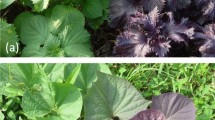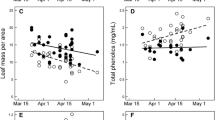Abstract
The widespread phenomenon of red and yellow autumn leaves has recently attracted considerable scientific attention. The fact that this phenomenon is so prominent in the cooler, temperate regions and less common in warmer climates is a good indication of a climate-specific effect. In addition to the putative multifarious physiological benefits, such as protection from photoinhibition and photo-oxidation, several plant/animal interaction functions for such coloration have been proposed. These include (1) that the bright leaf colors may signal frugivores about ripe fruits (fruit flags) to enhance seed dispersal; (2) that they signal aphids that the trees are well defended (a case of Zahavi’s handicap principle operating in plants); (3) that the coloration undermines herbivore insect camouflage; (4) that they function according to the “defense indication hypothesis,” which states that red leaves are chemically defended because anthocyanins correlate with various defensive compounds; or (5) that because sexual reproduction advances the onset of leaf senescence, the pigments might indicate to sucking herbivores that the leaves have low amounts of resources. Although the authors of hypotheses 3, 4, and 5 did not say that bright autumn leaves are aposematic, since such leaves are chemically defended, unpalatable, or both, we suggest that they are indeed aposematic. We propose that in addition to the above-mentioned hypotheses, autumn colors signal to herbivorous insects about another defensive plant property: the reliable, honest, and critical information that the leaves are about to be shed and may thus cause their mortality. We emphasize that all types of defensive and physiological functions of autumn leaves may operate simultaneously.
Similar content being viewed by others
Literature Cited
Archetti, M. 2000. The origin of autumn colours by coevolution. J. Theor. Biol. 205: 625–630.
—— 2007a. Autumn colours and the nutritional translocation hypothesis: a theoretical assessment. J. Theor. Biol. 244:714–721.
—— 2007b. Colour preference as evidence for the theories on the evolution of autumn colours. J. Theor. Biol. 245: 595–596.
-- & S. P. Brown. 2004. The coevolution theory of autumn colours. Proc. Roy. Soc. London, Ser.
——. 2005. A test of the coevolution theory of autumn colours: colour preference ofRhopalosiphum padi on Prunus padus. Oikos 110: 339–343.
Brown, S. P. 2005. A view from Mars. Pp. 350–356in M. Ridley (ed.). Narrow roads of gene land—the collected papers of W. D. Hamilton volume 3—last words. Oxford University Press, Oxford.
Chalker-Scott, L. 1999. Environmental significance of anthocyanins in plant stress responses. Photochem. & Photobiol. 70: 1–9.
Chittka, L. &T. G. Döring. 2007. Are autumn foliage colors red signals to aphids? PLoS Biol. 5: 1640–1644.
Close, D. C. &C. L. Beadle. 2003. The ecophysiology of foliar anthocyanin. Bot. Rev. 69: 149–161.
Cook, A. D., P. R. Atsatt & C.A. Simon. 1971. Doves and dove weed: multiple defenses against avian predation. BioScience 21: 277–281.
Cott, H. B. 1940. Adaptive coloration in animals. Methuen & Co., London.
Diamond, J. 2005. Collapse. How societies choose to fail or succeed. Viking, New York.
Dixon, A. F. G. 1997. Aphid ecology. An optimization approach. Chapman and Hall, London.
Edmunds, M. &J. Grayson. 1991, Camouflage and selective predation in caterpillars of the poplar and eyed hawkmoths (Laothoe populi andSmerinthus ocellata). Biol. J. Linn. Soc. 42: 467–480.
Endler, J. A. 1984. Progressive background matching in moths, and a quantitative measure of crypsis. Biol. J. Linn. Soc. 22: 187–231.
Facelli, J. M. 1993. Experimental evaluation of the foliar flag hypothesis using fruits ofRhus glabra (L.). Oecologia 93: 70–72.
Faegri, K. &L. van der Pijl. 1979. The principles of pollination ecology. Ed. 3. Pergamon Press, Oxford.
Faeth, S. H., E. F. Connor &D. Simberloff. 1981. Early leaf abscission: a neglected source of mortality for folivores. Amer. Naturalist 117: 409–415.
Feild, T. S., D. W. Lee &N. M. Holbrook. 2001. Why leaves turn red in autumn. The role of anthocyanins in senescing leaves of red-osier dogwood. Pl. Physiol. 127: 566–574.
Fineblum, W. L. M. D. Rausher. 1997. Do floral pigmentation genes also influence resistance to enemies? TheW locus inIpomoea purpurea. Ecology 78: 1646–1654.
Furuta, K. 1986. Host preference and population dynamics in an autumnal population of the maple aphid,Periphyllus californiensis Shinji (Homoptera, Aphididae). J. Appl. Entomol. 102: 93–100.
Glinwood, R. &J. Pettersson. 2000. Movement by mating females of a host alternating aphid: a response to leaf fall. Oikos 90: 43–49.
Gould, K. S. 2004. Nature’s Swiss army knife: the diverse protective roles of anthocyanins in leaves. J. Biomedicine & Biotechnol. 2004(5): 314–320.
--,D. W. Lee & J. A. Callow (eds.). 2002a. Anthocyanins in leaves. Advances Bot. Res. 37.
Gould, K. S., S. O. Neill &T. C. Vogelmann. 2002b. A unified explanation for anthocyanins in leaves? Advances Bot. Res. 37: 167–192.
Grafen, A. 1990. Biological signals as handicaps. J. Theor. Biol. 144: 517–546.
Grubb, P. J. 1992. A positive distrust in simplicity—lessons from plant defences and from competition among plants and among animals. J. Ecol. 80: 585–610.
Hagen, S. B., I. Folstad &S. W. Jakobsen. 2003. Autumn colouration and herbivore resistance in mountain birch(Betula pubescens). Ecol. Letters 6: 807–811.
——. 2004. Autumn coloration as a signal of tree condition. Proc. Roy. Soc. London, Ser. B 271 (Suppl.): S184-S185.
Hamilton, W. D. &S. P. Brown. 2001. Autumn tree colours as a handicap signal. Proc. Roy. Soc. London, Ser. B 268: 1489–1493.
Harborne, J. B. 1982. Introduction to ecological biochemistry. Academic Press, London.
Hinton, H. E. 1973. Natural deception. Pp. 97–159in R. L. Gregory & E. H. Gombrich (eds.), Illusion in nature and art. Duckworth, London.
Hoch, W. A., E. L. Zeldin &B. H. McCown. 2001. Physiological significance of anthocyanins during autumnal leaf senescence. Tree Physiol. 21: 1–8.
——. 2003. Resorption protection. Anthocyanins facilitate nutrient recovery in autumn by shielding leaves from potentially damaging light levels. Pl. Physiol. 133: 1296–1305.
Holopainen, J. K. &P. Peltonen. 2002. Bright autumn colours of deciduous trees attract aphids: nutrient retranslocation hypothesis. Oikos 99: 184–188.
Karban, R. 2007. Deciduous leaf drop reduces insect herbivory. Oecologia 153: 81–88.
Kessler, A. &I. T. Baldwin. 2001. Defensive function of herbivore induced plant volatile emissions in nature. Science 291: 2141–2144.
Kettlewell, B. 1973. The evolution of melanism. Clarendon Press, Oxford.
Kozlowski, T. T. &S. G. Pallardy. 1997. Physiology of woody plants. Ed. 2. Academic Press, San Diego.
——. 1991. The physiological ecology of woody plants. Academic Press, San Diego.
Lachmann, M. L., S. Számadó &C. T. Bergstrom. 2001. Cost and conflict in animal signals and human language. Proc. Natl. Acad. Sci. U.S.A. 98: 13189–13194.
Lee, D. W. 2002. Anthocyanins in autumn leaf senescence. Advances Bot. Res. 37: 147–165.
——. 2002a. Why leaves turn red. Amer. Sci. 90: 524–531.
—— & —— 2002b. Anthocyanins in leaves and other vegetative organs: an introduction. Advances Bot. Res. 37: 1–16.
——. 2003. Pigment dynamics and autumn leaf senescence in a New England deciduous forest, eastern USA. Ecol. Res. 18: 677–694.
Lev-Yadun, S. 2001. Aposematic (warning) coloration associated with thorns in higher plants. J. Theor. Biol. 210: 385–388.
—— 2003a. Weapon (thorn) automimicry and mimicry of aposematic colorful thorns in plants. J. Theor. Biol. 244: 183–188.
—— 2003b. Why do some thorny plants resemble green zebras? J. Theor. Biol. 244: 483–489.
—— 2006. Defensive coloration in plants: a review of current ideas about anti-herbivore coloration strategies. Pp. 292–299in J. A. Teixeira da Silva (ed.), Floriculture, ornamental and plant biotechnology: advances and topical issues. Vol. IV. Global Science Books, London.
——. 2002. Defensive ant, aphid and caterpillar mimicry in plants. Biol. J. Linn. Soc. 77: 393–398.
——. 2004. When may green plants be aposematic? Biol. J. Linn. Soc. 81: 413–416.
——. 2002. Colour patterns in vegetative parts of plants deserve more research attention. Trends Plant Sci. 7: 59–60.
——, —— &G. Ne’eman. 2004. Plant coloration undermines herbivorous insect camouflage. BioEssays 26: 1126–1130.
Majerus, M. E. N. 1998. Melanism. Evolution in action. Oxford University Press, Oxford.
Matile, P. 2000. Biochemistry of Indian summer: physiology of autumnal leaf coloration. Exp. Gerontol. 35:145–158.
Merilaita, S. 2003. Visual background complexity facilitates the evolution of camouflage. Evolution 57: 1248–1254.
——. 1999. Optimization of cryptic coloration in heterogeneous habitat. Biol. J. Linn. Soc. 67: 151–161.
Midgley, J. J., M. A. Botha &D. Balfour. 2001. Patterns of thorn length, density, type and colour in African acacias. African J. Range Forage Sci. 18: 59–61.
Ougham, H. J., P. Morris &H. Thomas. 2005. The colors of autumn leaves as symptoms of cellular recycling and defenses against environmental stresses. Curr. Topics Developm. Biol. 66: 135–160.
Purser, B. 2003. Jungle bugs: masters of camouflage and mimicry. Firefly Books, Toronto.
Ridley, H. N. 1930. The dispersal of plants throughout the world. L. Reeve & Co., Ashford, UK.
Rolshausen, G. &H. M. Schaefer. 2007. Do aphids paint the tree red (or yellow) - can herbivore resistance or photoprotection explain colourful leaves in autumn? Pl. Ecol. 191: 77–84.
Rubino, D. L. &B. C. McCarthy. 2004. Presence of aposematic (warning) coloration in vascular plants of southeastern Ohio. J. Torrey Bot. Soc. 131: 252–256.
Ruxton, G. D., T. N. Sherratt &M. P. Speed. 2004. Avoiding attack. The evolutionary ecology of crypsis, warning signals & mimicry. Oxford University Press, Oxford.
Schaefer, H. M. &K. S. Gould. 2007. Modelling the evolution of leaf colouration with binary assumptions is barking up the wrong tree. J. Theor. Biol. 249: 638–639.
——. 2006. Plants on red alert: do insects pay attention? BioEssays 28: 65–71.
—— & —— 2007. Aphids do not attend to leaf colour as visual signal, but to the handicap of reproductive investment. Biol. Lett. 3: 1–4.
—— &D. M. Wilkinson. 2004. Red leaves, insects and coevolution: a red herring? Trends Ecol. Evol. 19: 616–618.
—— &D. J. Levey. 2004. How plant-animal interactions signal new insights in communication. Trends Ecol. Evol. 19: 577–584.
Sherratt, T. N., D. M. Wilkinson &R. S. Bain. 2005. Explaining Dioscorides’ “double difference”: why are some mushrooms poisonous, and do they signal their unprofitability? Amer. Naturalist 166: 767–775.
Sinkkonen, A. 2006a. Sexual reproduction advances autumn leaf colours in mountain birch(Betula pubescens ssp.czerepanovii). J. Evol. Biol. 19: 1722–1724.
——. 2006b. Do autumn leaf colours serve as a reproductive insurance against sucking herbivores? Oikos 113: 557–562.
Speed, M. P. &G. D. Ruxton. 2005. Warning displays in spiny animals: one (more) evolutionary route to aposematism. Evolution 59: 2499–2508.
Stiles, E. W. 1982. Fruit flags: Two hypotheses. Amer. Naturalist 120: 500–509.
Van Bael, S. A., J. D. Brawn &S. K. Robinson. 2003. Birds defend trees from herbivores in a Neotropical forest canopy. Proc. Natl. Acad. Sci. U.S.A. 100: 8304–8307.
Weiss, M. R. 1995. Floral colour change: a widespread functional convergence. Amer. J. Bot. 82: 167–195.
White, T. C. R. 2003. Nutrient retranslocation hypothesis: a subset of the flush-feeding/senescence-feeding hypothesis. Oikos 103: 217.
Wickler, W. 1968. Mimicry in plants and animals. Weidenfeld and Nicolson, London.
Wilkinson, D. M., T. N. Sherratt, D. M. Phillip, S. D. Wratten, A. F. G. Dixon &A. J. Young. 2002. The adaptive significance of autumn leaf colours. Oikos 99: 402–407.
Willson, M. F. &W. G. Hoppes. 1986. Foliar ‘flags’ for avian frugivores: signal or serendipity? Pp. 55–69in A. Estrada & T. H. Fleming (eds.), Frugivores and seed dispersal. Dr. W. Junk, Dordrecht.
—— &C. J. Whelan. 1990. The evolution of fruit color in fleshy-fruited plants. Amer. Naturalist 136:790–809.
Yamasaki, H. 1997. A function of colour. Trends Pl. Sci. 2: 7–8.
Zahavi, A. 1975. Mate selection - A selection for a handicap. J. Theor. Biol. 53: 205–214.
——. 1977. The cost of honesty (further remarks on the handicap principle). J. Theor. Biol. 67: 603–605.
——. 1987. The theory of signal selection and some of its implications. Pp. 305–327in V. P. Delfino (ed.), International Symposium of Biological Evolution. Adriatica Editrica, Bari, Italy.
——. 1997. The handicap principle: a missing piece of Darwin’s puzzle. Oxford University Press, New York.
Author information
Authors and Affiliations
Rights and permissions
About this article
Cite this article
Lev-Yadun, S., Gould, K.S. What do red and yellow autumn leaves signal?. Bot. Rev 73, 279–289 (2007). https://doi.org/10.1663/0006-8101(2007)73[279:WDRAYA]2.0.CO;2
Issue Date:
DOI: https://doi.org/10.1663/0006-8101(2007)73[279:WDRAYA]2.0.CO;2




